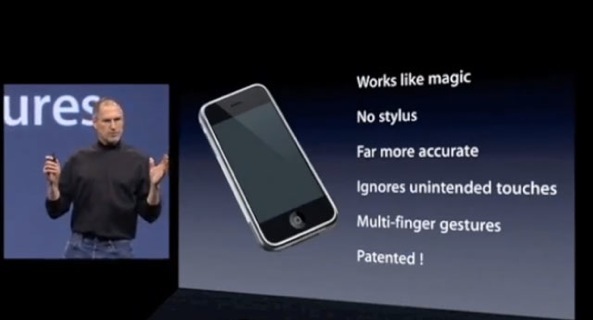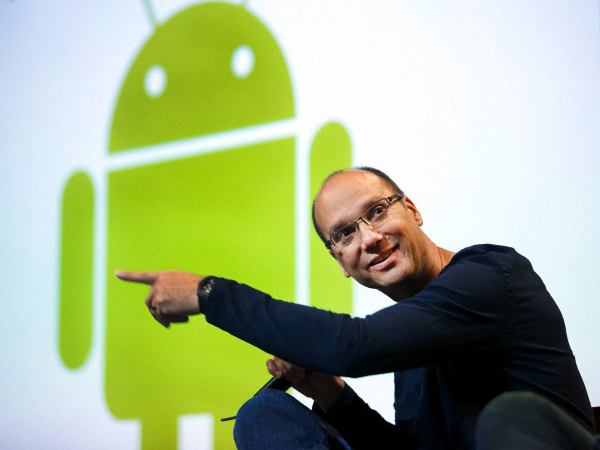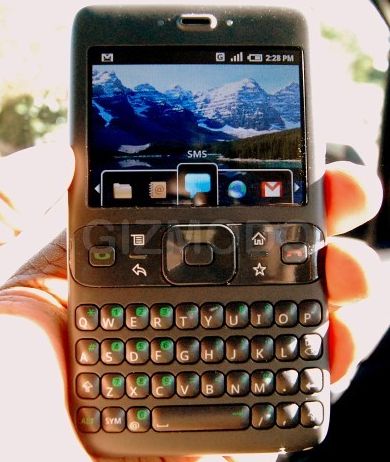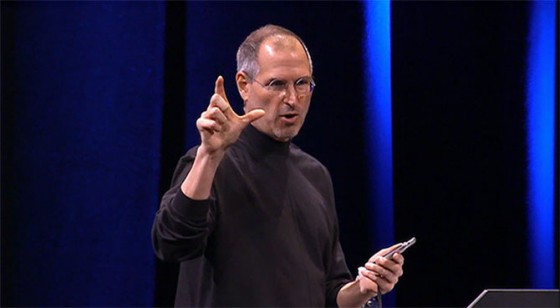I clearly remember September 2008 when the HTC G1 debuted in partnership with Google and T-Mobile. Google’s first usable Android-driven handset arrived some fifteen months after the iPhone had gone on sale in June 2007 and tech die-hards were startled that it didn’t incorporate the pinch-zoom gesture.
Android would be deployed across lots more handsets before eventually implementing not only pinch-zooming, but other familiar iPhone features as well. There was an unconfirmed rumor at the time that Google removed multitouch gestures from initial Android builds at Apple’s request.
In all honesty, the notion seemed a bit crazy. Why would Google take the iPhone head on and yet cave in to Apple’s demands? According to a new 272-page book titled Dogfight: How Apple And Google Went To War And Started a Revolution by Fred Vogelstein, Apple’s then CEO Steve Jobs imposed that choice on Google’s Android head Andy Rubin by sheer willpower…
Jobs thought Rubin was a “big, arrogant f**k,” according to a Dogfight excerpt spotted by Jay Yarow of BusinessInsider. The book also shatters some common misconceptions about Apple, Google, the iPhone and Android.
The Internet giant started work on Android after snapping up Andy Rubin’s startup for about $50 million back in 2005. At that particular point in time, Apple was already developing the iPhone project, Google’s then CEO Eric Schmidt still had a seat on Apple’s board of directors and Jobs had trust in Google’s cofounders Sergey Brin and Larry Page.
Despite Apple going to great lengths to keep the project shrouded in secrecy, people in the industry were aware that Apple was attempting to build a cell phone.
Ethan Beard, an early Android business development executive told the book author:
We knew that Apple was going to announce a phone.
Everyone knew that.
We just didn’t think it would be that good.
When Steve Jobs took the MacWorld Expo stage to deliver his legendary January 2007 iPhone introduction, Rubin was driving in a Las Vegas cab watching the keynote unfold.
He made the driver pull over so he could see the whole thing. He said, “Holy crap, I guess we’re not going to launch that phone.”
Indeed, here’s what an early Android handset prototype looked like pre-iPhone.
“What we had looked so … nineties,” an Android engineer told Vogelstein.
He was referring to the software Google was ready to launch a few months after the iPhone hit the market. Seeing what it’s up against, Google then rebooted Android by starting from scratch and eventually released the G1 in September 2008.
By that time, the iPhone had already been fifteen months on the market.
After seeing the G1 and new Android build, Jobs went berserk:
“Everything is a f**king rip off of what we’re doing,” Jobs said of Android.
The mercurial CEO insisted Google make a bunch of changes:
There was a meeting with Jobs, Scott Forstall, who designed the iPhone’s software, and Google’s Larry Page, Alan Eustace, and Rubin. Vogelstein cautions that it was hard to know exactly what happened in the meeting, but says that it was confrontational and nasty.
“It got incredibly personal,” says one Apple executive who was briefed by Jobs on the meeting. “Jobs said that Rubin was steamed, telling him his position was anti-innovation.
And this is where Steve was demeaning to Andy, saying Andy was trying to be like him, look like him, have the same haircut, the same glasses, the same style.”
Interestingly enough, Rubin himself was described as being a tyrant with Google employees, abrasive and difficult to work with. Anyway, as a result of the meeting Google had agreed to drop multitouch features like pinch zooming.
Steve Jobs demonstrates pinch-zooming at the January 2007 iPhone introduction.
The company also changed the Android phone unlock feature and Jobs even told Google how to take things out of Android. Rubin went through the roof over the concessions his bosses were willing to make in order to avoid Jobs’s wrath.
Bottom line: after a few Android iterations, Google felt confident enough to add Apple’s iPhone features like the pinch zoom gesture, prompting the iPhone maker to go thermonuclear on Android by launching proxy legal fights against prominent Android backers like HTC, Motorola and Samsung.
As for Rubin, he eventually stepped down as Android’s lead in March 2013.
One juicy gossip has it that Rubin was forced to quit, allegedly because current CEO and co-founder Larry Page saw him as a threat because his influence was growing exponentially on booming Android device activations.
Hungry for more?
Here’s another sample excerpt, via Amazon.
The fifty-five miles from Campbell to San Francisco is one of the nicest commutes anywhere. The journey mostly zips along the Junipero Serra Freeway, a grand and remarkably empty highway that abuts the east side of the Santa Cruz Mountains. Known as 280 to locals, it is one of the best places in Silicon Valley to spot a start-up tycoon speed-testing his Ferrari and one of the worst places for cell phone reception. For Andy Grignon in his Porsche Carrera, therefore, it was the perfect place for him to be alone with his thoughts early on January 8, 2007.
This wasn’t Grignon’s typical route to work. He was a senior engineer at Apple in Cupertino, the town just west of Campbell. His morning drive typically covered seven miles and took exactly fifteen minutes. But today was different. He was going to watch his boss, Steve Jobs, make history at the Macworld trade show in San Francisco. Apple fans had for years begged Jobs to put a cell phone inside their iPods so they could stop carrying two devices in their pockets. Jobs was about to fulfill that wish. Grignon and some colleagues would spend the night at a nearby hotel, and at 10:00 a.m. the following day they—along with the rest of the world—would watch Jobs unveil the first iPhone.
Getting invited to one of Jobs’s famous product announcements was supposed to be a great honor. It anointed you as a player. Only a few dozen Apple employees, including top executives, got an invite. The rest of the spots were reserved for Apple’s board of directors, CEOs of partners—such as Eric Schmidt of Google and Stan Sigman at AT&T—and journalists from around the world. Grignon got an invite because he was the senior engineer for all the radios in the iPhone. This is a big job. Cell phones do innumerable useful things for us today, but at their most basic they are fancy two-way radios. Grignon was in charge of the equipment that allowed the phone to be a phone. If the phone didn’t make calls, connect with Bluetooth headsets, or connect to Wi-Fi setups, Grignon had to answer for it. As one of the iPhone’s earliest engineers, he’d dedicated two and a half years of his life—often seven days a week—to the project. Few deserved to be there more than he did.
But as Grignon drove north, he didn’t feel excited. He felt terrified. Most onstage product demonstrations in Silicon Valley are canned. The thinking goes, why let bad Internet or cell phone connections ruin an otherwise good presentation? Jobs’s presentations were live, however. It was one of the things that made his shows so captivating. But for those in the background, such as Grignon, few parts of the job caused more stress. Grignon couldn’t remember the last time a Jobs show of this magnitude had gone sideways. Part of what made Steve Jobs such a legend was that noticeable product-demo glitches almost never happened. But Grignon found it hard to recall the last time Jobs was so unprepared going into a show.
Grignon had been part of the iPhone launch-preparation team at Apple and later at the presentation site in San Francisco’s Moscone Center. But he had rarely seen Jobs make it all the way through his ninety-minute show without a glitch. Jobs had been rehearsing for five days, yet even on the last day of rehearsals the iPhone was still randomly dropping calls, losing the Internet connection, freezing, or just shutting down.
“At first it was just really cool to be at rehearsals at all—kind of like a cred badge. ‘Fuck yeah, I get to hang out with Steve,’” Grignon said. Like everything else that surrounded Jobs, the preparations were as secret as a U.S. missile attack on Afghanistan. Those who were truly in felt as if they were at the center of the universe. From Thursday through the end of the following week, Apple completely took over Moscone. Backstage it built an eight-by-eight-foot electronics lab to house and test the iPhones. Next to that it built a greenroom with a sofa for Jobs. Then it posted more than a dozen security guards twenty-four hours a day in front of those rooms and at doors throughout the building. No one got in or out without having his or her ID electronically checked and compared with a master list that Jobs had personally approved. More security checkpoints needed to be cleared once visitors got inside. The auditorium where Jobs was rehearsing was off-limits to all but a small group of executives. Jobs was so obsessed with leaks that he tried to have all the contractors Apple had hired for the announcement—from people manning booths and doing demos to those responsible for lighting and sound—sleep in the building the night before his presentation. Aides talked him out of it.
“It quickly got really uncomfortable,” Grignon said. “Very rarely did I see him become completely unglued. It happened. But mostly he just looked at you and very directly said in a very loud and stern voice, ‘You are fucking up my company,’ or, ‘If we fail, it will be because of you.’ He was just very intense. And you would always feel an inch tall [when he was done chewing you out].” Grignon said that you would always ask yourself two questions during one of these lectures: “‘Is it my shit that broke this time?’ and ‘Is it the nth time it broke or the first time?’—because that actually mattered. The nth time would frustrate him, but by then he might have figured out a way around it. But if it was the first time, it added a whole new level of instability to the program.” Grignon, like everyone else at rehearsals, knew that if those glitches showed up during the real presentation, Jobs would not be blaming himself for the problems, he would come after people like Grignon. “It felt like we’d gone through the demo a hundred times and that each time something went wrong,” Grignon said. “It wasn’t a good feeling.”
* * *
The iPhone didn’t work right for a good reason; it wasn’t close to being finished. Jobs was showing off a prototype. He just didn’t want the public to know that. But the list of things that still needed to be done before the iPhone could be sold was enormous. A production line had yet to be set up. Only about a hundred iPhones even existed, all of them of varying degrees of quality. Some had noticeable gaps between the screen and the plastic edge, others had scuff marks on the screen. Thus no one in the public was allowed to touch an iPhone after Jobs unveiled it, despite a day of press briefings and a whole exhibit set up for them in the convention center. The worry was that even the best prototypes wouldn’t stand close scrutiny, Grignon said. They’d look fine at a distance and for Jobs’s demo, but if you held one in your hand, “You would laugh and say, ‘Wow, this thing really looks unfinished.’”The phone’s software was in even worse shape. A big chunk of the previous four months had been consumed figuring out why the iPhone’s processor and its cell radio wouldn’t reliably communicate. This huge problem was akin to a car with an engine that occasionally doesn’t respond to the accelerator, or wheels that occasionally don’t respond to the brake pedal. “It almost brought the iPhone program to a halt,” Grignon said. “We had never seen a problem this complicated.” This was ordinarily not a problem for phone makers, but Apple’s obsession with secrecy had kept Samsung, the manufacturer of the phone’s processor, and Infineon, the maker of the phone’s cell radio, from working together until Apple, in desperation, flew teams of engineers from each company to Cupertino to help fix the problem.
Jobs rarely backed himself into corners like this. He was well-known as a master taskmaster, seeming to always know just how hard he could push his staff so that they delivered the impossible. But he always had a backup, a Plan B, that he could go to if his timetable was off. Six months prior he’d shown off Apple’s upcoming operating system, Leopard. But that was after letting the date for the final unveiling slip.
But Jobs had no choice but to show off the iPhone. He had given this opening keynote at every Macworld since he’d returned as Apple’s CEO in 1997, and because he gave public presentations only once or twice a year, he had conditioned Apple fans to expect big things from them. He’d introduced iTunes here, the iMac that looked like a fancy desk lamp, the Safari web browser, the Mac mini, and the iPod shuffle.
It wasn’t just his own company that Jobs had to worry about disappointing this time. AT&T was expecting Jobs to unveil the iPhone at Macworld too. In exchange for being the exclusive carrier of the iPhone in the United States, AT&T had given Jobs total control of the design, manufacture, and marketing of the iPhone. It had never done anything like this before. If Jobs didn’t launch on time, AT&T could back out of its deal. It’s not hard to explain that a product called the iPhone that couldn’t make calls would sell poorly. Days before, Jobs had flown to Las Vegas to give AT&T’s top mobile executives a limited demo of the iPhone. But they were expecting a full show at Macworld.
Lastly, the iPhone was truly the only cool new thing Apple was working on. The iPhone had been such an all-encompassing project at Apple that this time there was no backup plan. “It was Apple TV or the iPhone,” Grignon said. “And if he had gone to Macworld with just Apple TV [an experimental product back then], the world would have said, ‘What the hell was that?’”
Dogfight is available on the iBookstore for $12.99.
I just bought the book the other day, but haven’t had the time to read it through yet. When I do, I’ll be making sure to blog here about any relevant and previously unknown details which led to the creation of the iPhone and Android.



